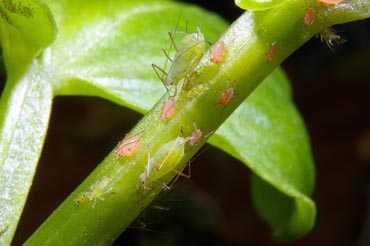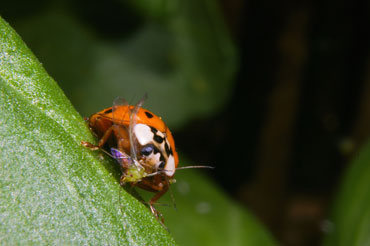Evolution, ecosystems may buffer some species against climate change
Although ecologists expect many species will be harmed by climate change, some species could be buffered by their potential to evolve or by changes in their surrounding ecosystems.

These pea aphids, a common agricultural pest of peas, alfalfa, and other legumes, are helping researchers understand how local populations of species may respond to environmental change. A recent study led by UW–Madison zoology professor Anthony Ives shows that some species may be protected from the effects of climate change by the ability to evolve quickly or shifts within their ecosystems.
Photo: courtesy Anthony R. Ives and Jason P. Harmon/UW-Madison
Researchers at UW–Madison and the University of Arizona are using a common agricultural insect pest to understand how ecological and evolutionary factors drive population shifts in the face of a changing environment.
A study appearing March 6 in the journal Science shows that both ecological interactions within a food web and the potential for rapid evolutionary adaptation play critical roles in determining how populations of the legume-loving pea aphid fare during increasing bouts of hot weather, one aspect of predicted climate change.
One of the most important lessons of the work is that predictions of the consequences of environmental change on populations must take into account both ecological and evolutionary complexities, says Jason Harmon, a UW–Madison postdoctoral researcher and lead author of the new study.
“If you’re interested in environmental change and how species are going to respond to it, you can’t just look at a single species in isolation as it is right now. You have to think about those other species around it, and you have to think about the species’ potential to change along with the environment,” he says.

A ladybeetle munches on a pea aphid, a common agricultural pest of peas, alfalfa, and other legumes.
Photo: courtesy Anthony R. Ives and Jason P. Harmon/UW-Madison
Bouts of high temperature decrease pea aphid reproduction, but inherited bacteria living symbiotically within the aphids bestow them with a possible evolutionary defense. “Because we can experimentally manipulate aphid bacteria, we have an excellent model system to explore evolutionary adaptation,” says University of Arizona professor of ecology and evolutionary biology Nancy Moran, a co-author of the study.
The researchers showed that the degree of heat tolerance conferred by the symbiotic bacteria influenced whether the aphids thrived or succumbed to experimental heat stress in the field. The result shows that the potential for rapid evolution can have a large impact on how populations respond to environmental change, they say.
The detriment of the additional hot days also depended on which of two different predatory ladybeetle species was present, showing that the structures of local food webs may mitigate environmental changes.
“Right now, a lot of work is focused on just individual species,” says UW–Madison zoology professor Anthony Ives. “To understand what happens to any one particular species, you need to broaden your scope and consider other species.”
While predicting the response of species to climate change is complicated, Ives says, the new study may help de-mystify complex processes by identifying specific factors that are relevant. He hopes that this new work will help other scientists take a broad ecological and evolutionary view while studying the effects of environmental change.
“We’re identifying things that people should look for because they could be important, as opposed to saying it’s just too complicated,” he says. “It’s difficult, but not impossible.”



